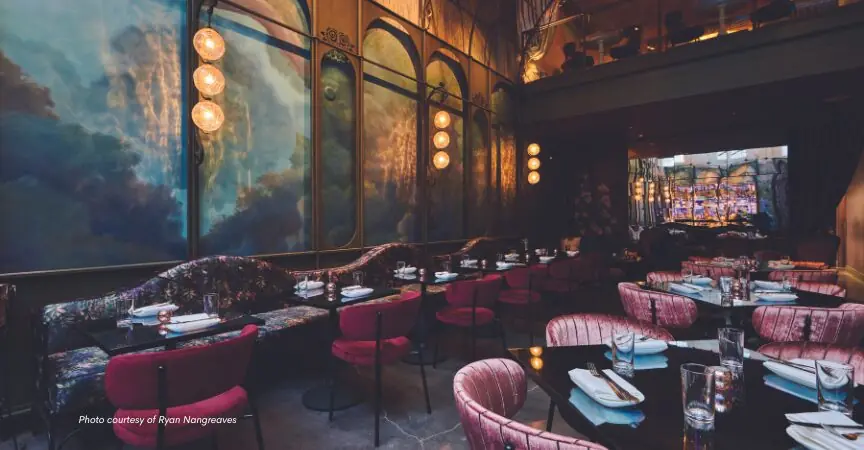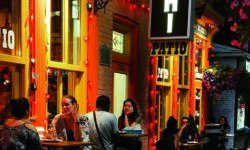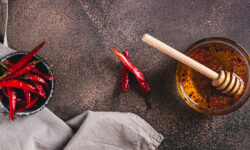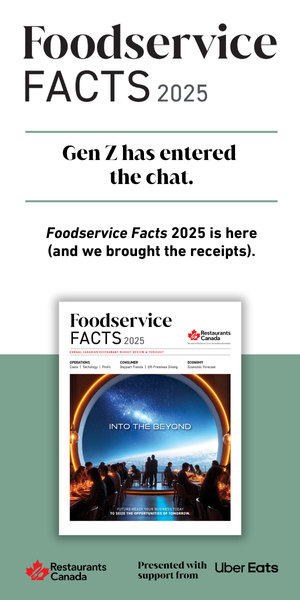A Hospitality Dream that Plays with Reality
On Queen Street West in Toronto lies and/ore, a magical restaurant that knows how to make an entrance. You may never have seen anything quite like it, but the and/ore experience comes together seamlessly—as if guided by foresight or grand design—with a confidence that suggests its visionaries not only know what they are doing, but what the industry needs.
Stepping inside and/ore is a little like falling through the looking glass. The main floor and mezzanine — collectively known as “Above Ground”— invite guests to be their most playful selves. Dominated by a hand-painted, two storey mural by artists Tisha Myles and Jack Phelps of New Love Collective, the whimsical Rococo-inspired backdrop reaches from forest floor to sky, providing the perfect set piece for Executive Chef’s Missy Hui’s picnic experience of shared plates and snacks created to surface and spin the diverse flavours and textures of modern Canadian cuisine. The menu and environment invite guests to step away from the street and into a kind of liminal space where champagne or a selection from Abigail Rubiales’ perfectly paired and distinctive cocktail menu is not only recommended, but “just the thing.”
As surprising as and/ore’s Above Ground space is, it’s only part of the restaurant’s cabinet of surprises. There is also Below Ground, a cave-inspired dining room, where adventurous guests descend for an intimate and enigmatic dining experience. Here, Chef Missy presents a culinary exploration in harmony with the season and accentuated with assertive and distinctive wines and classic cocktails.
At the helm of this enchanting operation are four partners: Executive Chef Missy Hui, Business Operations Manager Kailey DeRubeis, General Manager Abigail (Abby) Rubiales, and an Australian expat mining engineer, Jaimie Donovan, who put the team together with nothing but a dream and some enviable Internet sleuthing skills. “I had left a career and was looking for something new and creative and ultimately landed on hospitality because it merged a lot of passions and things I wanted to do,” Jaimie recalls. “I found there are so few female owners and executive chefs in the space. I started cold calling people—which was admittedly odd, as I have no background in hospitality—and I first got to Kailey, who agreed to meet with me and then to keep in touch. Finding a chef with the experience and talent to make the idea come to life was key. After lots of calls I finally met Missy for coffee, and we “dated” for about a year. I sort of stalked Missy until she realized this was the job of her dreams.”
The team refers to this period as “stalking and talking followed by dating and waiting”, but with four strong, unique and established personalities and professions, they recognized that the partnership would be complex. “We were getting to know each other,” Missy acknowledges. “You have to know you can work together, be a team and disagree, yet still be able to move forward. Jaimie’s not in hospitality, but we’re slowly getting her there. Some of us have worked together before, but some of us have not, so it was really important to make sure the partnership was going to be successful with the financial, client and public-facing pressures that would come.”
There is risk in the hospitality business, and the and/ore team went into it with their eyes open. “I had been well-warned, and it was interesting when I was talking to people, they fell into two clear groups,” Jaimie recalls. “Roughly half the people I called were extremely optimistic and enthusiastic about the hospitality industry, and genuinely believed everyone should get into it. The other half said, “Never do it. You’ll lose all your money.” There was no grey area. So, I went with the optimists.”
An experience and menu that favours personality over “personalization”
and/ore’s food program is what Missy calls “modern Canadian”, centred around her own experience. “I am a modern Canadian,” she asserts. I am half Chinese. My mom is English-Irish. I grew up in Hamilton in a predominantly Italian neighborhood. We were the only non-Italians in the whole neighborhood. I spent a lot of my career in Italian food, yet I’m French trained. So, I don’t like the word “fusion”. I like the term “modern Canadian” because that’s my lived experience. My food is a representation of myself, but also my staff as they contribute a great deal to its creation. I hope that by the end of our first year everyone on my team sees themselves somewhere in the menu, and it’s already happening.”
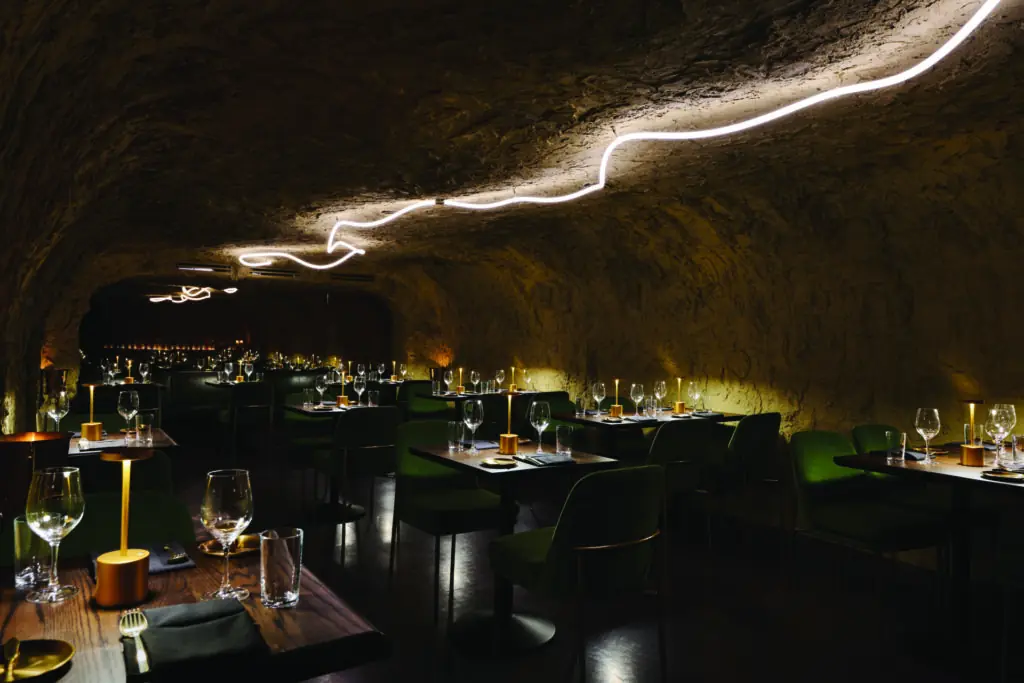
The team attributes much of the design to Jaimie, who has since earned the nickname, “Smallwares”. She shares that the intent was to create a space that transports people from their day-to-day to a fanciful, eclectic environment they can lose themselves in. “The Above Ground, or top floor, was inspired by the idea of a stumbling upon an old greenhouse in a whimsical forest. The Below Ground is a descent, which was a little bit self-indulgent as it speaks to my background in mining. I love working underground, so the cave makes me happy. They completely contrast each other. The top is ornate and visually overwhelming, and the basement is simple and clean.”
Guests who don’t know what they’re walking into are blown away, and those who have done a little research find the experience of actually being in the space transformational. “We love the way Missy has presented the food in the different spaces. The top is centred around picnic-inspired sharing dishes that speak to the garden theme, but downstairs is Missy’s best work. It’s high-end, beautiful food, and to be eating it in a basement is the definition of unexpected.
Kailey feels that one of the biggest compliments is when they have a guest who has dined both Above and Below Ground and gush about both experiences. “I think we’ve done a really great job differentiating the spaces and making them both feel just as special.” Missy calls this “equal and opposite”, noting that a lot of their discussions on menu and pricing aimed to ensure that people would find value in both spaces, understanding them as distinct experiences that defy comparison. The chambered and womb-like sensory deprivation of the Below Ground dining room (which guests access via elevator) blocks out the distraction and distortion of the outside world, creating an intimacy and focus on the tasting menu itself.
For the bar, Abby wanted to design a cocktail program that didn’t play into smoke, mirrors or gimmickry. “I wanted to complement and not overpower the food. The challenge was that, with so many flavours, spices and elements in the menu, I wanted something palate-cleansing and approachable that was at once familiar and unfamiliar. We arrived at a split offering of classics and signatures, really diving into the name “and/ore”.”
Each outstanding classic cocktail has a Wonderland-style alternative universe twin, so as Abby puts it, “If you like a Cosmo, here is a Cosmo. Or, you can do something really interesting and have one that’s white and glittery and maybe has a different citrus. Some people really lean into it and go through the whole catalogue, but if you like what you like, I respect that. It is funny though to see people who normally stick to their standards really lean into what we’re offering and enjoy it. While I was developing the menu, I saw the space as it was coming together with the clouds on the mezzanine and I wanted to something airy, fluffy, fun and visual. I developed the Cotton Candy Old Fashioned… and people lost their minds. I guess I’ll be spinning cotton candy forever. I’m now the hardest-working carny in North America.”
Friendship, respect and a shared vision of culture
Shared values and a common vision for the culture were as central to the business plan as the partnership complement, the menus, the venue and the design. “There’s a shared respect for what each of us brings to the table,” says Jaimie. “Our different backgrounds are important in making each other think about why we’re doing what we’re doing. I have asked some “dumb questions”, but at least they get asked so we can think about why we’re doing something the way we’re doing it, instead of just doing what everyone else in the industry does. I’m not saying every question sparks a revolution, but they all receive a thoughtful, respectful response.”
The leadership team jointly manage the space, while each has her own discreet area of responsibility. Missy of course runs food but is also in charge of health and safety. In addition to her core responsibilities, Kailey has become the defacto HR department (something she disputes). Abby runs bar, but also oversees and/ore’s staff-directed tip pilot. “We check in with each other and really try and manage as a team,” Missy explains. “Our teams also self-direct and try and manage as teams.”
“With four partners, you’re obviously working with four personalities,” Kailey shares. “We’re all very different. We share similar values, ethos and approach to leadership including how we want to be represented, both from a personal standpoint and how we want to be represented as a brand and a restaurant. We have a lot of debates, but they’re so healthy and communicative. We actually don’t often all agree right away, so there’s value in having four different personalities because we can focus on our areas of the business. I look at a cocktail recipe, and I don’t really know what’s going on, but I don’t have to because Abby’s brain works so fast and she’s behind every amazing idea that’s come out of the bar along with its beautiful staff. I think we complement each other really well.”
Missy agrees, pointing out that they’re sitting on a banquette (which they now call “the bench”) Jaimie swore she’d never have in the restaurant. “That’s when we really knew that this was going to work and that this was magic,” Missy says. “Literally, we all have different perspectives, and we rarely agree 100% on anything, but we still manage to be highly productive. That’s how we knew this was going to work. I’m not afraid to say, “This is a horrible idea,” or “I hate this,” and they’re not afraid to tell me “Too bad. You’re being stupid.” There’s confidence and there’s friendship and there’s no hurt feelings, just progress.”
Each team member has in turn recruited their own teams, applying the same personal and professional values filter to each selection. “Shared values and culture really does start at the top,” Missy says. “It was important to us that people like the people they work with and feel good going to work every day. That they feel there’s opportunity for professional development, and that it’s about more than whether you’re going to be 10 minutes late for work. We’ve been very, very lucky. Not only in the reception we’ve had so far, but in the people we’ve managed to convince to join us before any of this was anything. “Recruit” is really the wrong word. We really just put our vision for the culture into the universe and waited to see what would happen. My sous team is new to me. They’re phenomenal and we’re really aligned. The way we work together as partners has really trickled down into our teams. We are collectively building this brand, and everyone is emotionally invested in it.”
The team approached employee onboarding with a simple, compelling principle: “We can train you and we can teach you, but we can’t teach you to care.” Hiring happened through wide-ranging conversations, designed to get to know potential employees, several of whom have no previous hospitality experience. The sense was that if people cared and wanted to learn, they were an ideal fit with the restaurant and its leadership.
“Our staff see the respect and how we interact with each other, especially during service,” Kailey points out. “We try and embody what we want to see in our staff. We met a lot of people, and we’re so lucky to have the staff we have. We’re just a few months in and we’re already seeing some beautiful friendships evolving in the space among staff. It feels like we really got that part right.”
The amount of internal employee referrals within such a short timeline gives testimony to that idea. “It’s a real endorsement when somebody on our staff actively brings in someone they know,” says Missy. “Our culture is building just based on the expansion of our own internal network. People recognize that this is a nice place to work, and our staff has done a great job in bringing that feeling to the guest. We get great reviews about the food and the interiors, but we get a lot about the staff and how kind and warm they are. There’s something to be said for that, because it’s very genuine.”
“All we ever wanted was for us and our team was to be able to show up as our genuine selves,” Kailey says. “And then translate that to the guests.”
A concept built on belonging
A large part of what makes and/ore so special is that it’s the successful child of conscious compromise; an unapologetically out-of-the-box, yet utterly harmonized amalgamation of its founders’ unique visions.
Beyond food, drink and design, the crucial, intangible element of success that truly sets a restaurant apart is the sense of belonging. More than just a place to be to drink and dine, great operators understand that they are crafting an experience, a memory, a moment where every patron feels like a part of a larger story. This feeling of inclusivity and warmth transforms a meal into a memory and makes guests yearn to return that truly elevates a restaurant from good to unforgettable.
This isn’t lost on the co-founders, but it’s also a natural extension of the people they are as opposed to a strategy. “I think we do a great job of offering such a diverse set of elements that we naturally attract a lot of different kinds of people who really want to be a part of the experience. Sure, some people just want to come and take a photo of the cave but, more often than not, we get guests who are really engaged and love our story, want to understand more and ask questions about the mural, the space and the fabrics. For us, that’s really cool. We love people who are just as excited as we are to be in the space.”
The sense of immersion and commitment across the restaurant team is measured in their perception of the passage of time, Abby notes. “We’re all putting in 12 million hours a day and late in the evening Kailey and I are always in the office and we ask ourselves, “Wow, where did today go…what happened?” I feel silly saying it. It’s not a normal workday. I don’t feel taxed or over-exerted because we generally have a good time. The music’s great, the food’s wonderful and people are having a good time—all the components really play into each other and create this exceptional environment where you don’t feel like you’re at work.”
Missy agrees. “We’re working very hard, but how many people get the opportunity to open a restaurant? We’re building a restaurant to be a business, but once we realized we’re also really building a restaurant for ourselves, it took on a life of its own. We treat it like our own space, and it’s very freeing to know that, if you want to cook a certain dish or do a cocktail special or have your family in, that works. Jaimie wanted a specific feeling when you come to the restaurant, and we’ve done that. Aesthetically, it’s very nuanced and stunning and we’ve worked with some amazing artists, but we built this on a feeling. That comes through because we’re all living small portions of each other’s hospitality dreams.”
Against the odds and against the grain
The and/ore team always believed they were going to be successful based on confidence in the business design and having the right people, place and menu, but the timeline surprised them all. Missy is frank: “We’ve blown it out of the water. Once we invited everyone we knew and then saw other people start to come who no one on the team had a connection with, we knew we’d exceeded our expectations. There are so many talented people in hospitality—front of house, back of house—you can do everything right and still not be successful. It’s a finicky field. For us to be sitting here having this conversation and for things to be going this way and our staff to be who they are… All of it is surreal and it feels like a dream.”
With more than half of Canadian restaurants operating at a loss or barely breaking even, some would say such an ambitious (even audacious), high-level concept should not have worked. “We didn’t intend to be this ambitious,” Kailey says, “but then we built a cave in the basement. If people only understood the amount of planning, work and HVAC we put in… We didn’t know if people would love it or hate it, but it turns out they love it.”
The team is acutely aware that maintaining their success will be the real test, and the hardest part, with the longest stretch of road out in front. “It’s also still incredibly risky,” Jaimie acknowledges. “For someone outside the industry, it was scary as hell. We are offering something unique and special, but the key is the belonging part, because the real test is if people keep coming back.”
As a commercial “product”, and/ore is almost a dare to the foodservice market itself, which is currently betting high on low-cost, high-volume operations. They’ve been smart with their menu pricing, delivering high-quality items while keeping affordability and accessibility top of mind. They’ve also been extremely shrewd and intentional, offering the right thing, at the right time for what people actually need. Something real.
“We’re hospitality people through and through,” says Missy. “This is our career, our livelihood, and probably all we’ve ever known and wanted. and/ore is a platform for us to be creatively fulfilled, but at the end of the day, we’re having a good time. I don’t know how else to put it. I wish we could say some of it is more intentional, but a lot of it is the magic of hospitality that made us all fall in love with it. It just feels like a gift.”
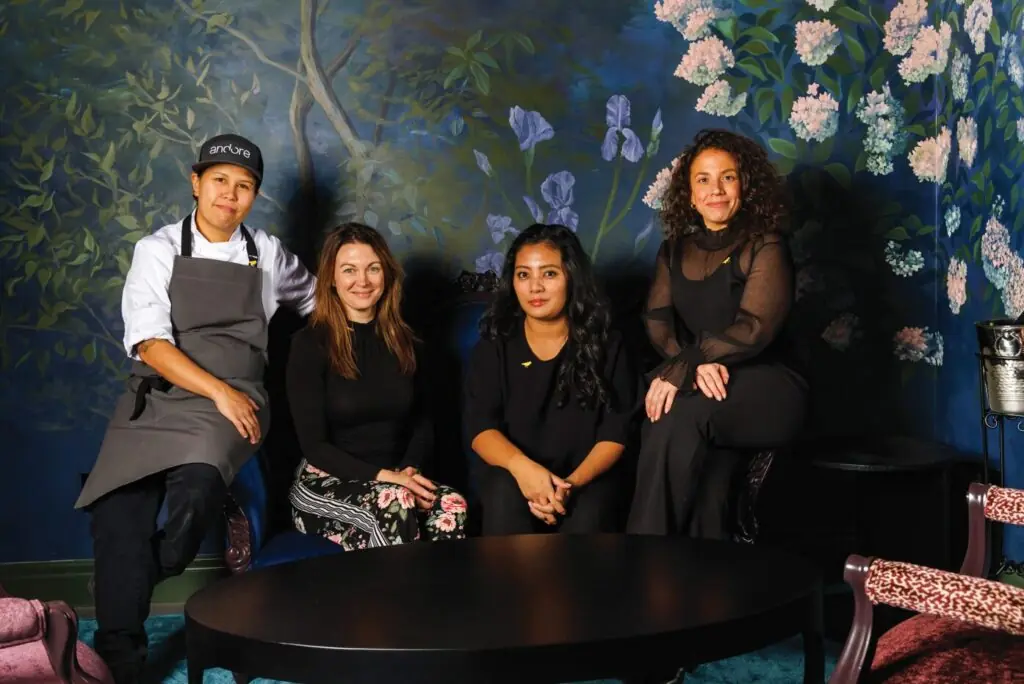
The and/ore team picks their favourite food and drink.
Missy: Sous Chef Ted’s Hamachi Crudo and, on the tasting menu, Sous Chef Milo’s maitake dish. They’re stunning, and I don’t want to eat my own food. I’m sorry Abby’s a carny now, but I’d order the Old Fashioned. It’s a perfect, excellent cocktail.
Abby: I would have 44 of Missy’s deviled eggs. I don’t even need a beverage.
Kailey: I agree with Abby, but I’d push it to 50 and add our signature Negroni. Abby’s take on a Negroni was one of the most surprising, beautiful cocktails I’ve had in a long time.
Jaimie: The chicken liver pate and any glass of champagne recommended by Krysta Oben, our collaborator at Grape Witches.




